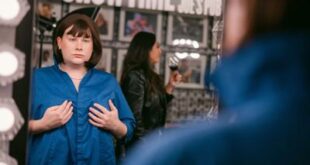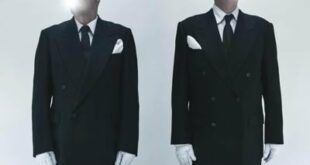
Mattea Kennedy is a full-time intimacy co-ordinator on film and television sets.
“It’s a better way to make art,” says Mattea Kennedy about the use of intimacy co-ordinators on film and TV sets.
Originally from London, England, but now living in Toronto, Kennedy has more than 25 years of experience in film, television and theatre, including serving as an artists’ model during theatre college and a stage manager in live theatre, but she now devotes herself full-time to the job of intimacy co-ordinator. Here, she tells Briony Smith about the growing role of maintaining performers’ dignity and comfort on sets.
I first heard about this role from a colleague of mine who was working as an intimacy co-ordinator at the time. What intrigued me was that this job intertwined my love of people, sexuality and art. I was excited about a dedicated specialist who could advocate for performers, and add constructively to the creative vision of scenes involving nudity, simulated sex or hypersensitive material. I knew that I wanted to be of service in that way.
My background was a good start as I had studied dance, movement, performance and photography, and already knew how to break down a script to extract specific information. I was accepted into an accredited program by the Intimacy Professionals Association based in L.A. It was so interesting to learn about the nuance of depicting intimacy onscreen. The psychology of arousal is fascinating to me: it can be used in character development, or to add to the power dynamics or rhythm of a scene. There was a lot to learn about blocking for camera or the way in which a scene is captured on film. Many things are not what they seem and there is a lot of careful crafting that goes into making a scene of sexual intimacy appear real. Working on choreography in the classroom setting was hilarious. We all had to take turns being the intimacy co-ordinator, cast and director. The whole room was like one giant clothed round-robin simulated orgy.
This kind of training is becoming more common, as there is a growing need for intimacy co-ordinators. Nowadays, performers never work without a stunt co-ordinator and an intimacy co-ordinator furthers this same kind of professionalism. We have to be aware that shooting film and TV is not democratic. There is a necessary hierarchy; it’s like being on a ship. We are evolving in the greater culture in our awareness of power dynamics and re-examining how these kinds of structures deserve our continued processing. It’s an evolution. And we have made huge amounts of progress. The intimacy co-ordinator role itself is a newer discipline and there is no requirement to hire one. There are only recommendations and guidelines. As this role becomes more accepted and then formalized in our industry, I believe we will see the benefits holistically. It’s a better way to make art.
Planning out scenes has to start with a core question: What are we trying to express with this method of visual storytelling? A movement or choreography background can be helpful, as is an understanding of photography or filmmaking, and the way a camera sees. Foreshortening, for example, gives you some leeway to create the illusion that body parts are touching, even though they’re offset or staggered in real life. The mind of the viewer is also a powerful tool and we can block in a way that is recognizable, whilst not being graphic, because the back of a shoulder moving rhythmically or a head bobbing in a certain way can be enough!

Maddie Ziegler starred as a teenager diagnosed with the rare reproductive disorder in “Fitting In,” for which Mattea Kennedy worked on set as an intimacy co-ordinator.
In my new project, “Fitting In,” my services were required for 30 different kinds of scenes. This semi-autobiographical film from writer-director Molly McGlynn tells the story of a 16-year-old girl, Lindy (Maddie Ziegler), who is diagnosed with the rare reproductive disorder Mayer-Rokitansky-Küster-Hauser (MRKH) Syndrome, and her journey of self-discovery and acceptance, so it included everything from implied nudity and skinny dipping to simulated sexual encounters, both solo and between characters, along with prescription dilator use. These scenes depicting the portrayal of medical intervention were new to me.
I have a myriad of wonderful items in my kit to cover any kind of intimacy, though. Yoga mats for custom “barrier wear” cuts down on friction and unwanted stimulation. Strapless thong underwear covers genitalia but allows a performer to appear nude from behind. Camel-nots make for a seamless panty, and there are many types of nipple covers to wear under a bra or create a nude illusion, or be worn in an underwater scene or bath or shower sequence. I carry razors and shaving cream to remove hair from intimate areas; sometimes an intimacy co-ordinator has to become a bit of an esthetician to reach those hard-to-shave areas. Plus many types of tape: waterproof, toupé, clothing tape, tuck tape. And a mini Pilates ball to jam between performers simulating penetration and save them from bruising themselves or each other. Can’t forget the tons of breath mints, breath strips and gum. Oh, and a 12-inch dildo that can be sat on in order to make manual stimulation look convincing. I live in fear of having my bags searched by the OPP!
Every day on the job is different. There’s a lot of lying on the floor next to prop beds waiting to lube performers’ faces between takes in order for them to look authentic, or hiding silently in the dark in set closets to pop out and tweak modesty garments. Usually, however, an on-set day will involve meeting with the performers first to make sure they have signed their riders and feel well. I offer them help with modesty garments or barrier wear. We reiterate any expressed boundaries and reminders about injuries or ticklish zones to scene partners, and generally check everyone is feeling confident in the upcoming scene. If we are extremely lucky, there may be time for a clothed rehearsal to nail down the beats of the scene. Intimacy itself is so innate to the human experience that, as the viewer, we absolutely know when it does not look right, whether it’s the alignment in body position or signs of arousal. We read each other’s body language. It has to be perfect.
The intimacy co-ordinator is then invited to set for private blocking. All scenes involving nudity or simulated sexual content take place on a closed set, which means that only essential personnel are present during filming or can view these scenes at the end of the shooting day. I can assist the on-set dresser with robing the cast between takes if needed, and offer gum, breath mints, water or mouthwash, plus retape barrier wear, and any other support as required. Once the scenes are done, I check back in with the cast to make sure everything went well for them. A set report is generated after each shooting day to give a brief summary of the intimacy co-ordinator responsibilities carried out.
There’s a misconception that we are the sex police, trying to stop or ban intimacy and sexual content from appearing onscreen. If anything, we are professional facilitators — the best person to help your steamy scenes look great is a dedicated expert. So, in reality, it’s just the opposite!
*****
Credit belongs to : www.thestar.com
 MaharlikaNews | Canada Leading Online Filipino Newspaper Portal The No. 1 most engaged information website for Filipino – Canadian in Canada. MaharlikaNews.com received almost a quarter a million visitors in 2020.
MaharlikaNews | Canada Leading Online Filipino Newspaper Portal The No. 1 most engaged information website for Filipino – Canadian in Canada. MaharlikaNews.com received almost a quarter a million visitors in 2020.







